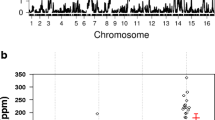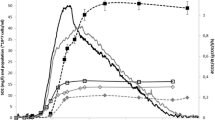Abstract
Sulfite is widely used as an antioxidant in food production. In beer brewing, sulfite has the additional role of stabilizing the flavor by forming adducts with aldehydes. Inadequate amounts of sulfite are sometimes produced by brewer's yeasts, so means of controlling the sulfite production are desired. In Saccharomyces yeasts, MET10 encodes a subunit of sulfite reductase. Partial or full elimination of MET10 gene activity in a brewer's yeast resulted in increased sulfite accumulation. Beer produced with such yeasts was quite satisfactory and showed increased flavor stability.
Similar content being viewed by others
References
Baroni, M., Livian, S., Martegani, E., and Albaghina, L. 1986. Molecular cloning and regulation of the expression of the MET2 gene of Saccharomyces carevisiae . Gane 46: 71–78.
Cherest, H., Thao, N.N., and Surdin-Kerjan, Y. 1985. Transcriptional regulation of the MET3 gene of Saccharomyces cerevisiae . Gene. 34: 269–281.
Hansen, J., Cherest, H., and Kielland-Brandt, M.C. 1994. Two divergent MET10 genes, one from Saccharomyces cerevisiae and one from Saccharomyces carls-bergensis, encode the α subunit of sulfite reductase and specify potential binding sites for FAD and NADPH. J. Bacteriol. 176: 6050–6058.
Korch, C., Mountain, H.A., and Byström, A.S. 1991. Cloning, nucleotide sequence and regulation of MET14, the gene encoding the APS kinase of Saccharomyces cerevisiae . Mol. Gen. Genet. 229: 96–108.
Langin, T., Faugeron, G., Goyon, C., Nicolas, A., and Rossignol, J.-L. 1986. The MET2 gene of Saccharomyces cerevisiae: molecular cloning and nucleotide sequence. Gene 49: 283–293.
Mountain, H.A., Byström, A.S., Larsen, J.T., and Korch, C. 1991. Four major transcriptional responses in the methionine/threonine biosynthetic pathway of Saccharomyces cerevisiae . Yeast 7: 781–803.
Sangsoda, S., Cherest, H., and Surdin-Kerjan, Y. 1985. The expression of the MET25 gene of Saccharomyces cerevisiae is regulated transcriptionally. Mol. Gen. Genet. 200: 407–414.
Thomas, D., Cherest, H., and Surdin-Kerjan, Y. 1989. Elements involved in S-adenosylmethionine-mediated regulation of the Saccharomyces cerevisiae MET25 gene. Mol. Cell. Biol. 9: 3292–3298.
Thomas, D., Barbey, R., and Surdin-Kerjan, Y. 1990. Gene-enzyme relationship in the sulfate assimilation pathway of Saccharomyces cerevisiae. Study of the 3′-phosphoadenylylsulfate reductase structural gene. J. Biol. Chem. 265: 15518–15524.
Brewer, J.D. and Fenton, M.S. 1980. The formation of sulphur dioxide during fermentation. Rroc. Conv. Inst. Brew., Australia and New Zealand section 16: 155–164.
Dufour, J.-P., Carpentier, B., Kulakumba, M. Van Haecht, J.-L., and Devreux, A. 1989. Alteration of SO2 production during fermentation. Proc. Eur. Brew. Conv. Congr., Zürich, pp. 331–338.
Gyllang, H., Winge, M., and Korch, C. 1989. Regulation of SO2 formation during fermentation. Proc. Eur. Brew. Conv. Congr., Zürich, pp. 347–354.
Korch, C., Mountain, H.A., Gyllang, H., Winge, M., and Brehmer, P. 1991. A mechanism for sulfite production in beer and how to increase sulfite levels by recombinant genetics. Proc. Eur. Brew. Conv. Congr., Lisbon, pp. 201–208.
Thomas, D., Barbey, R., Henry, D., and Surdin-Kerjan, Y. 1992. Physiological analysis of mutants of Saccharomyces cerevisiae impaired in sulphate assimilation. J. Gen. Microbiol. 138: 2021–2028.
Gjermansen, C. 1991. Comparison of genes in Saccharomyces cerevisiae and Saccharomyces carlsbergensis. PhD thesis, University of Copenhagen, Denmark.
Hansen, J., and Kielland-Brandt, M.C. 1994. Saccharomyces carlsbergensis contains two functional MET2 alleles similar to homologues from S. cerevisiae and S. monacensis . Gene 140: 33–40.
Nilsson-Tillgren, T., Gjermansen, C., Holmberg, S., Petersen, J.G.L., and Kielland-Brandt, M.C. 1986. Analysis of chromosome V and the ILV1 gene from Saccharomyces carlsbergensis . Carlsberg Res. Commun. 51: 309–326.
Petersen, J.G.L., Nilsson-Tillgren, T., Kielland-Brandt, M.C., Gjermansen, C., and Holmberg, S. 1987. Structural heterozygosis at genes ILV2 and ILV5 in Saccharomyces carlsbergensis . Curr. Genet. 12: 167–174.
Gjermansen, C. and Sigsgaard, P. 1981. Construction of a hybrid brewing strain of Saccharomyces carlsbergensis by mating of meiotic segregants. Carlsberg Res. Commun. 46: 1–11.
Orr-Weaver, T.L., Szostak, J.W., and Rothstein, R.J. 1981. Yeast transformation: A model system for the study of recombination. Proc. Natl. Acad. Sci. USA 78: 6354–6358.
European Brewing Convention. Analytica Microbiologica. 1977. J. Inst. Brew. 83: 109–118.
Nordlöv, H. 1985. Formation of sulphur dioxide during beer fermentation. Proc. Eur. Brew. Conv. Congr., Helsinki, pp. 291–298.
Meilgaard, M.C. 1975. Flavor chemistry of beer: part II: flavor and threshold of 239 aroma volatiles. MBAA Tech. Quart. 12: 151–168.
Hinze, H. and Holzer, H. 1986. Analysis of the energy metabolism after incubation of Saccharomyces cerevisiae with sulfite or nitrite. Arch. Microbiol. 145: 27–31.
Maier, K., Hinze, H., and Leuschel, L. 1986. Mechanism of sulfite action on the energy metabolism of Saccharomyces cerevisiae . Biochim. Biophys. Acta 848: 120–130.
Pickerell, A.T.W., Hwang, A., and Axcell, B.C. 1991. Impact of yeast-handling procedures on beer flavor development during fermentation. J. Am. Sec. Brew. Chem. 49: 87–92.
Pilkington, B.J. and Rose, A.H. 1988. Reactions of Saccharomyces cerevisiae and Zygosaccharomyces bailii to sulphite. J. Gen. Microbiol. 134: 2823–2830.
Stratford, M., Morgan, P., and Rose, A.H. 1987. Sulphur dioxide resistance in Saccharomyces cerevisiae and Saccharomycodes ludwigii . J. Gen. Microbiol. 133: 2173–2179.
Dufour, J.-P. 1991. Influence of industrial brewing and fermentation working conditions on beer SO2 level and flavour stability. Proc. Eur. Brew. Conv. Congr., Lisbon, pp. 209–216.
Bamforth, C.W. and Anness, B.J. 1981. The role of dimethyl sulphoxide reductase in the formation of dimethyl sulphide during fermentations. J. Inst. Brew. 87: 30–34.
Anness, B.J. and Bamforth, C.W. 1982. Dimethyl sulphide—a review. J. Inst. Brew. 88: 244–252.
Cherest, H. and Surdin-Kerjan, Y. 1992. Genetic analysis of a new mutation conferring cysteine auxotrophy in Saccharomyces cerevisiae: updating of the sulfur metabolism pathway. Genetics 130: 51–58.
Sherman, F. 1991. Getting started with yeast, pp. 3–21 in Methods in Enzymology 194: Guide to Yeast Genetics and Molecular Biology. Guthrie, C. and Fink, G.R. (eds.). Academic Press Inc., San Diego, CA.
Rikkerink, E.H.A., Magee, B.B., and Magee, P.T. 1988. Opaque-white phenotype transition: a programmed morphological transition in Candida albicans . J. Bacteriol 170: 895–899.
Hough, J.S., Briggs, D.E., Stevens, R., and Young, T.W. 1982. p. 881 in Malting and Brewing Science, Vol. II, Hopped Wort and Beer, 2nd Ed. Chapman and Hall, London.
Hadfield, C. 1994. Construction of cloning and expression vectors, pp. 17–48 in Molecular Genetics of Yeast. A Practical Approach. Johnston, J.R. (ed.). Oxford University Press, Oxford, UK.
Schiestl, R.H. and Gietz, R.D. 1989. High efficiency transformation of intact yeast cells using single stranded nucleic acids as a carrier. Curr. Genet. 16: 339–346.
Sigsgaard, P. and Rasmussen, J.N. 1985. Screening of the brewing performance of new yeast strains. J. Am. Soc. Brew. Chem. 43: 104–108.
Grant, W.M. 1947. Colorimetric determination of sulfur dioxide. Anal. Chem. 19: 345–346.
Haukeli, A.D. and Lie, S. 1971. The influence of α-acetohydroxy acids on the determination of vicinal diketones in beer during fermentation. J. Inst Brew. 77: 538–543.
Author information
Authors and Affiliations
Rights and permissions
About this article
Cite this article
Hansen, J., Kielland-Brandt, M. Inactivation of MET10 in brewer's yeast specifically increases SO2 formation during beer production. Nat Biotechnol 14, 1587–1591 (1996). https://doi.org/10.1038/nbt1196-1587
Received:
Accepted:
Issue Date:
DOI: https://doi.org/10.1038/nbt1196-1587
- Springer Nature America, Inc.
This article is cited by
-
Identification of new Saccharomyces cerevisiae variants of the MET2 and SKP2 genes controlling the sulfur assimilation pathway and the production of undesirable sulfur compounds during alcoholic fermentation
Microbial Cell Factories (2015)
-
MET2 affects production of hydrogen sulfide during wine fermentation
Applied Microbiology and Biotechnology (2014)
-
Secretion expression of SOD1 and its overlapping function with GSH in brewing yeast strain for better flavor and anti-aging ability
Journal of Industrial Microbiology and Biotechnology (2014)
-
Flavour-active wine yeasts
Applied Microbiology and Biotechnology (2012)
-
Development of Saccharomyces cerevisiae Producing Higher Levels of Sulfur Dioxide and Glutathione to Improve Beer Flavor Stability
Applied Biochemistry and Biotechnology (2012)





